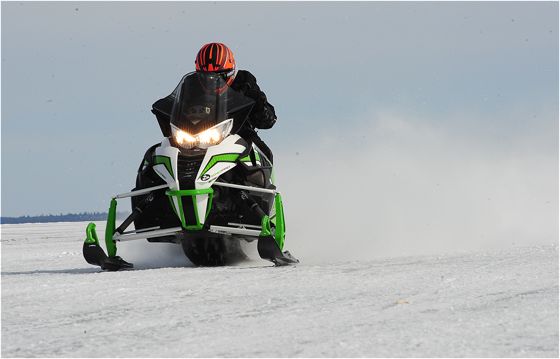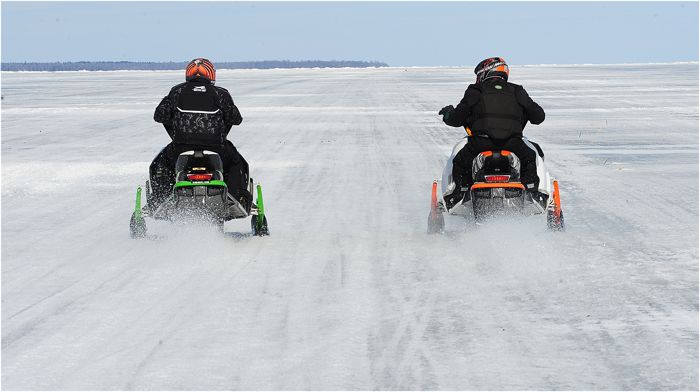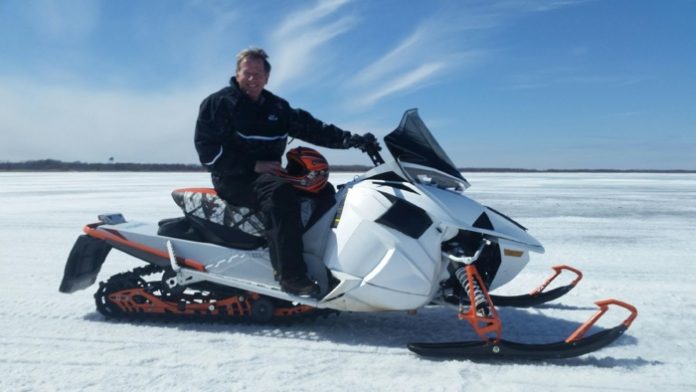
Last week, Arctic Cat Snowmobile Product Manager Troy Halvorson read THIS editorial by Jim Dimmerman about the new 2017 Arctic Cat 9000-Series Turbo engine powering the Thundercat and other 9000-Series models. As a dealer, tuner and drag racer who knew the original series of Thundercats from 1993-2002 as well as anyone on the planet, Dimmerman expressed his unique perspective on the old and new T-Cats.
What was missing from the story, thought Halvorson, was that Dimmerman hadn’t yet ridden the new 998 turbo.
A few phone calls later, Halvorson had arranged a pre-production 2017 ZR 9000 Limited 137-in. for Dimmerman to ride on the last bit of easily accessible ice on Lake of the Woods in northern Minnesota. Better still, there would also be a 2016 ZR 9000 with the Suzuki 1100 turbo 4-stroke to compare against in a series of half-mile drag runs. And who better to be the other rider than his longtime friend and mentor, Arctic Cat racing and engineering legend Larry Coltom!?
The morning consisted of Dimmerman spending time on the Suzuki-powered 9000 Series turbo, running up and down a long drag strip on the ice as well as ripping around some pseudo-trails along the lakeshore. He followed that with an afternoon aboard the new 2017 9000 Series with the 998cc Yamaha turbo engine, running multiple passes that included accelerations from various speeds; on/off accelerations similar to trail riding; and several half-mile long top speed tests.
After all that, Dimmerman and Coltom began a series of side-by-side drag races, swapping sleds multiple times to get the fullest comparison possible.
Having methodically tested each sled/engine in multiple ways, Dimmerman spoke candidly about what it’s like to ride the new 180-hp triple turbo:

Expectations
I came into this test expecting the new Thundercat to be as fast or faster than the old 1000cc 2-stroke Thundercat. That expectation was based on the 180-hp class of the new engine, knowing that the old 1000 triple 2-stroke was about 175hp.
I have all kinds of experience with 2-stroke, triple-cylinder Thundercats, but far less experience with turbo-charged sleds. I’ve driven turbo-charged cars and trucks for decades, but not sleds. In fact my only experience was with a Suzuki 9000 at the Ride with the Champs a few years back. Frankly speaking, I was not impressed. The throttle response on that twin cylinder turbo was very sluggish. The only fun in driving it was 40 feet off the corners when the turbo finally hit with power.
So my biggest expectation with the new triple turbo was that throttle response had to be much, much quicker than the old turbo. I want quick seat-of-the-pants push the moment I hit the throttle. My next expectation was sound. When your riding your sled the engine is talking to you. It’s connected to your thumb. You can make it sing to you. I loved the distinct sound of the 2-stroke triple. The twin Suzuki turbo sang a low flat note. I was not satisfied with the sound of that engine. I was hoping the new Yamaha 3-cylinder turbo would bring back that triple hum accompanied with the turbo push.

998 Turbo
It was such a pleasure to get to know this engine. The first time I took it onto the lake, on the initial takeoff acceleration, the dreaded turbo lag was gone! The power came smoothly with the throttle, No waiting, very linear. Back off the throttle, then stab it: whoosh! It responds. That was a huge difference compared to the Suzuki.
So right away, before I’d even opened it up, I knew its response was way quicker. Then I started going wide-open throttle, and it gave me exactly what it had promised: quick response and linear power all the way through.
What Yamaha has done by controlling the intake airbox pressure, it has made a huge improvement in maintaining throttle response. It reacts the way I want an engine to react.
If you got on this not knowing it was a turbo, you probably wouldn’t suspect it was. That goes back to its nearly non-existent lag and its linear power delivery. You simply don’t feel the turbo.
Sound
Welcome to a unique NEW sound in snowmobiles! This new 3-cyclinder turbo is like a new wave of music. It’s all its own. It is very quiet.
Yes you get some 3-cylinder hum, and yes it makes a mechanical revving sound but its more like a whoosh. Three pulses pushing this turbocharger and three separate intake injectors added more musicians to the concert. Actually I wasn’t even aware of the sound. It was so subtle that it just blended in with the rush of acceleration. It doesn’t announce itself like the 2-strokes do. And it’s far more pleasant to my ears than the turbo twin.
Manners & Rideability
I’ve driven many near-200-hp engines in my life. Many of those have been race engines whose sole purpose is to go fast on a perfectly flat surface, and their power can be made to hit like a hammer.
This is NOT a race sled. This is NOT a big hit combo that’s only destined for running on drag strips. Arctic Cat built this Thundercat that not only flies across lakes, but will easily be driven on trails & ditches and off trail powder. This is exactly the power delivery to be smooth and steady. Its power is there all of the time, and lots of it for all kinds of snow conditions.
Arctic’s engineers have truly put together a package of finely tuned clutches, an impeccable Yamaha engine, and a proven performance chassis.
You can have your cake and eat it too…
Top Speed
It ran 122 mph in a half-mile all day long, literally back-to-back runs on ice that had a couple dozen windblown patches of snow on it. Certainly not ideal conditions. I could noticeably feel the affect on speed and acceleration. I saw 123 mph twice. And Sandberg got 124 mph twice, but he weighs less than I do. Believe me, there’s a lot left in this package!
Self-Adjusting TEAM Clutches
KUDOS to the drivetrain group at Arctic Cat…The new clutching system is a story that’s maybe gotten a little lost in all the hype of 180-hp. This system is going to revolutionize snowmobile drivetrain performance.
The drive belt is the heart of every snowmobile’s drivetrain and performance. Once a belt wears just the slightest bit, you have to adjust for belt deflection or your sled won’t perform correctly. And I’ve come to believe most people never adjust belt deflection, so they suffer a bottom end bog and loss of top speed.
With the roller-bearing drive system on the TEAM clutch that enables the self-adjusting TEAM driven clutch, this sled always starts in the lowest gear ratio, so takeoff is going to always be crisp. And it’s going to stay at right rpm to full shift. The belt always goes back to the top of the driven and to the bottom of the drive. It’s automatically adjusting for belt wear as it happens.
No other drive system in the industry is doing that automatically, no other brand has this system. For any other brand to maintain proper performance will require manual adjustments every 50-100 miles if they want to maintain top performance.
Larry told me that had two machines that went 6000 miles and still hadn’t reached the maximum capacity for belt wear.
This is a massively significant development. People might not understand it, it’s a bit complicated to explain – even though its very simple in design – but it’s a huge improvement in the consistency of performance, the maintenance of belt life, and the lower gear on takeoff.
2-Stroke T-Cat
People sometimes forget, but the three-cylinder Suzuki 2-stroke engine has some acceleration lag. That’s part of the signature feel and sound of that engine. It needs to get up in RPM before the hit is hard, and it takes a moment for that wind-up. The midrange pull of the new Thundercat is very similar to that of the old T-Cat.
On a long stretch of lake, most of the original stock 2-stroke Thundercats went about 110 mph. With a low windshield; a lowered front and rear suspension; aggressive clutching; and 200 ice picks, my race sleds could get another 10 to 15 mph in that 1/2 mile distance. But that would NOT be trail rideable, at all. We ran much heavier clutch weights and significantly steeper helixes in the driven clutch, so it shifted hard and quickly. It would take a race prepped old T-Cat to match what this new turbo Thundercat does completely stock!
Suzuki Turbo
The nature of that engine is to run low RPM, building torque down low. Its musical note is flat. The lag in turbo response is significant and noticeable, almost annoyingly so. Frankly, it’s not a powerplant that I’d be interested in riding because of the lag. Once the power comes on, it accelerates well. It feels like low 170-hp. It got me to the 115-117 mph range every time I ran it long, but it felt as if that’s all it had left in stock form. I know it’s a great responder to aftermarket boost increase, and it’s a really durable engine.
Verdict
They did it! These guys have built the replacement for the original Thundercat AND the Suzuki 9000. This performance sled accelerates through the entire range, from clutch engagement to the all-smiles-triple-digits. It’s exactly what you would expect from a 180 hp.
As I said before: Yamaha builds really great performance engines; Arctic Cat builds really great performance chassis and the most significant clutch package in memory. It’s a spectacular marriage.
Quiet, smooth and complete delivery on the expectation I have for a sled to wear the legendary “Thundercat” name. At 120-plus mph out of the box, it’s the fastest production snowmobile in the world. Plus it’ll go through bumps, trails and rough stuff all day long, which is a hallmark of Arctic Cat sleds. I can’t wait to ride one on the trails next winter. These guys really gave us what we wanted!
IT’S BACK! Long live the Thundercat…

Dimmerman on the 2016 Arctic Cat ZR 9000 with the Suzuki turbo.


Dimmerman and Coltom! It was pretty damn cool to see these two run up and down the ice groove, tucked low to cheat the wind while ringing ever last mph out of their sleds, just like they’d done hundreds if not thousands of times during their former careers as Team Arctic Sno Pro racers.

This was the typical spread between the 2017 Arctic Cat 9000 998cc turbo (left) and the 2016 9000 1100cc turbo (right) after a half-mile race.



John,
You’re website is trying to get me to spend my money again. 🙂
Great article though. Maybe it’s time to move my 2011 EXT Turbo on down the road. 🙁
Does it get any cooler than this? I don’t think so. From what I can hear on this video, that new Yamaha engine sounds sweet!
thats a thorough and informative story. very well done. jim if you are answering questions, can you say how the thundercat compares to the 800 twin?
Great write up!!
Thanks Guys for the great write up. It sounds like this machine is going to be the total package. How did it handle through the corners?
I can’t wait for those clutches to make it into the whole line up.
So suddenly the engine that has been leading the pack power wise since 2008 has terrible turbo lag and has a flat tone? Time will tell if the new engine has the durability and the tunability of the zuke turbo. Till then, long live the 1100 suzuki turbo!
Great information! Thanks for the great comparison between the old and new!
Jim, it was great talking to you this past week about the Thunder Cat. I am still tracking down the info that you requested from the archives. Hope you received the photos via text that i sent you.
Sure look like fun machines
Mark,I’d have to agree with you on that one.
I guess Cat needs to move on from Suzuki. I’ll will never forgive Yamaha for the pos 08 Nytro they sold me. As frustrating as my 012 Turbo has been at times, nothing, I mean nothing is worse than the 4s Yamahas , I’ve owned!
Come to think about it, I said at the time, if they put that 3cyl Yamaha motor in a Crossfire, that would be the perfect sled. Oops!!
i wanted to like and buy the suzuki turbo. then i rode one and agree with jims opinion. don’t like the laziness from turbo lag. so ive been a happy owner of a 800 but i still want a faster sled. maybe the new turbo.
What an great experience to archive in the Arctic Cat history books. Another benchmark in snowmobile performance has been set by Arctic Cat.
However, it is not a Suzuki turbo engine in the 9000. It is an Arctic Cat designed engine. Missing this critical detail takes away from the huge step Cat took away from Suzuki back in the day and have since established their own industry leading line up of engines to compliment their industry leading chassis’s.
Fast8. Sorry but we did not test against the 800. I’m sure the 8 would leave respectfully with the turbo, but it would be no match for top end..You know the answer to this equation..Thanks for the question.
Mark, I can see your an Arctic Cat guy because your on this site. I’m sorry if I was dissing a little hard on the Suzuki turbo.
I hope you can understand that as a long time racer, throttle response was a huge part of my life. I may be a bit of a stickler when it comes to explaining what I feel.
I sure know that the Suki turbo is and will continue to be a very strong motor package for Arctic Cats. This new Thundercat is a stout package also.
Obviously I’m still a little stoked about going a buck twenty three on a stock production snowmobile…Thanks for you response.
@ Dieselmann
Regardless if AC did or did not design the 1100T it is built by Suzuki and IS a Suzuki engine.
To anyone who has complained of turbo lag on the Suzuki 1100T engine, you need to do an aftermarket engine tune/reflash. These engines were built to accept huge power and even at 300+ HP can live for thousands of miles without failure. I just hope the new Yamaha engine can hold up to the abuse us mountain riders running big hp will subject it too. Only time will tell….
The “turbo lag” claimed in this writeup, is vastly over stated, to try and hype the new engine.
Also, any “lag” is there because the guys at arctic cat that tune the ecu, and clutches designed in to be there.
The ecu controls the boost at all times. Any aftermarket tune, or even the cheap boondocker plug in control, bypasses this, and brings the boost on instantly.
The thing that bothers me the most is that, this fall and winter the forums will be full of guys complaining that their sled doesn’t pull 124 mph. I doubt that every sled built, will be setup, and tuned as this hand built prototype was, as I’m sure that every detail was checked over.
I don’t always agree with what others say on here, but Krom has a point in his last paragraph. Every sled as uncrated can benefit from a thorough break in and performance tuning if you want it to run as well as it can. It’s been this way from the beginning. I can’t say how many times I’ve heard people unjustly complain, over the years, on every make and model that was alledgedly defective, when it was either unrealistic expectations or just misfired maintenance. However as I read this article I do believe Jim is saying box stock verses box stock the new triple will be better. Neither is bad, it’s just progress. Yamaha has a long history of making good sled engines. Ask the guys who ran the 1977 440 Z’s against the 1977 440 SRX. Ask the guys who grass dragged stock C in the 1980’s with the 5000 FA El-Tigre’s against the 540 SRV or the Phazer. Horsepower was not a Yamaha problem. LOL. It all came down to who did their homework that weekend. Who had the set-up right for that track. Quite often that meant either first or fourth and usually the spread was barely two sled lengths. You coulda’ thrown Grandma’s quilt over the entire bunch on a good day, at the finish. Just sayin’.
I’ve ridden the Suzuki 9000 since it’s debut, albeit always in stock trim except for one day of riding various Speedwerx upgrades. They have all been VERY fast machines, very quiet. Every one I rode has had a lag in response.
I’ve ridden four different pre-production 2017 9000 series sleds with the new 998 turbo. The throttle (and turbo) response on every single one was WAY quicker.
These weren’t “handbuilt” sleds in the sense that they went through some kind of perfection process. I think every one of them had a serial number and will be sold to dealers through Special Services sometime in the coming months, then onto customers.
Most peoples’ sleds that don’t have the same performance as an identical, new version of that same sled, are slower because they haven’t adjusted for belt wear. That problem is solved with new TEAM system. I roll my eyes whenever an OEM throws the marketing “game changer” description to something, however, the new self-adjusting clutching package truly does change the game, at least for the vast majority of riders who never adjust belt deflection.
Nice write up again John thanks. It sure feels more true than the magazines.
This is the best performance sled for 2017 on the market. Or you are gona buy what ??
I hope the new sled buyers like it when they see it in the showrooms and buys it ,drives it and enjoys it.
Thats whats counts….
Your doing exactly what I like doing, about 50 miles south of me I assume.
Hard to notice the new turbo sound in the video, good to hear it sounds better then the Suzuki. Sure appears that you liked it.
I could have brought down my fine running 02 T-Cat from a little ways north, it can do 118 (GPS) on Lake of the Woods ice and is fully trail ride-able including reverse. 25T top gear, Ceramic coated BM Pipes, 1″ hacksaw, 192 studs, otherwise stock. Should have done 115 with your conditions.
Are the speeds you are registering verified GPS or radar? If so that is very impressive. I have been trying to get over 120 for many years and cannot do it. Were those sleds 129 or 137 tracks?
I AM (so) glad my major back operation went well 2 years ago…NOW I am really ready for the $now..great piece on the legends of the ice.
Now about that down payment…
Hi FeelTheThunder
This engineering 998 Turbo had a calibrated speedometer in it.
It’s calibration after our test was verified to be right on…
Both Turbos were 137″ tracks. Thanks for your response.
Jim,
Thanks for the fantastic article on the new Thundercat, I read it yesterday, it addressed many of my concerns about the machine, and I Snow-Checked mine at our dealer the first thing this morning! Without a doubt this is the most exciting sled to hit the market in recent history! Haven’t been this excited about a machine since I picked up my new 1994 Thundercat, which later evolved into an all out 1050 Hooper lake racer/asphalt sled that I owned for many years.
Winter can’t return soon enough, can ‘t wait to Feel the Thunder Again!
Dimmer good to see you back out having fun on a sled. I am sure the industry is missing you. I do. Pretty cool to see these newer sleds pushing past the numbers we used to get 20 plus years ago after spending thousands of dollars and loosing dependability. 180 hp and a warranty, how you beat that! Thanks for all the spoonfuls of information years ago! You the man!
Robert Z
The 180 HP appears to be very conservative. The new TCat model has given consistent results of over 200 HP on numerous dyno tests.